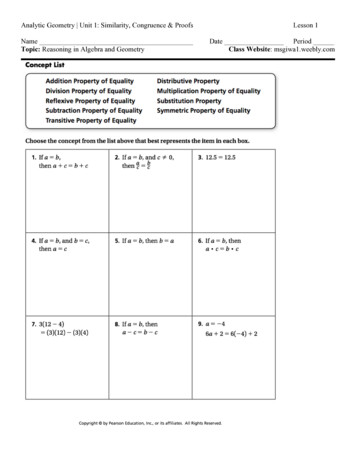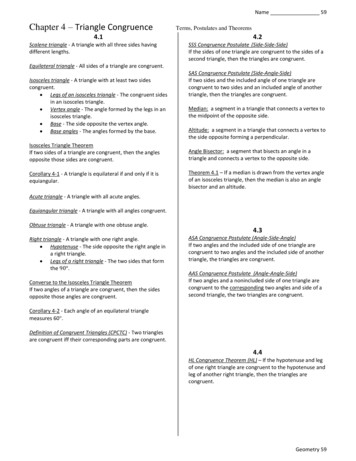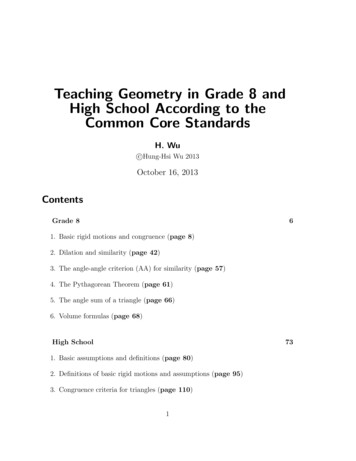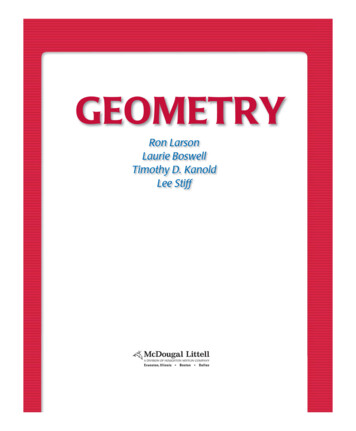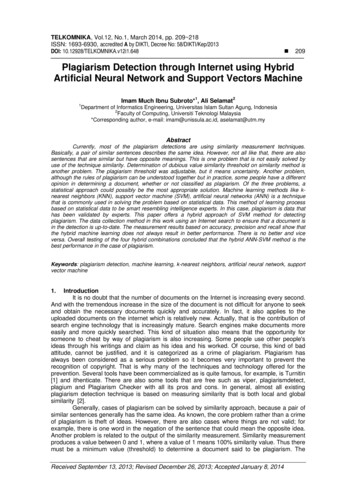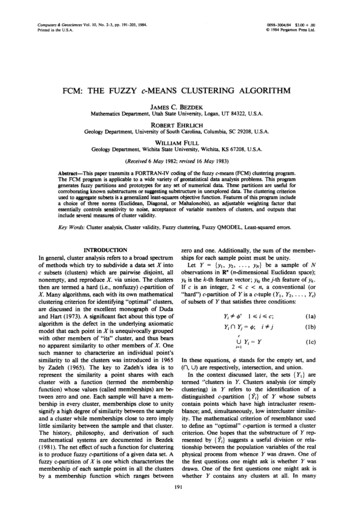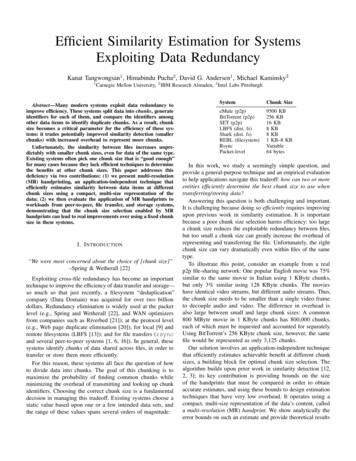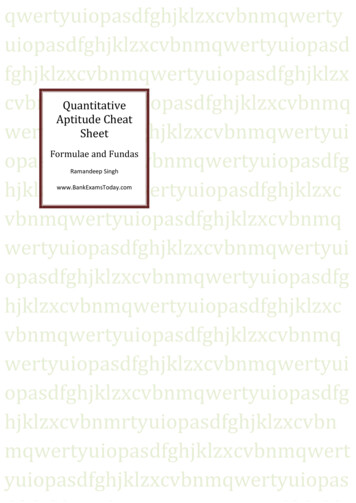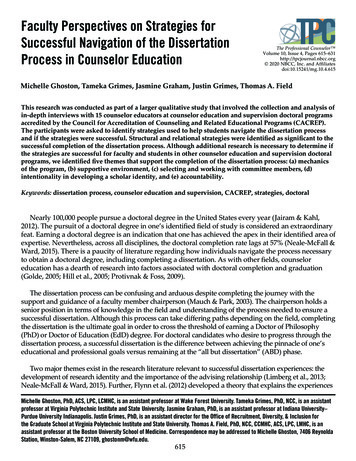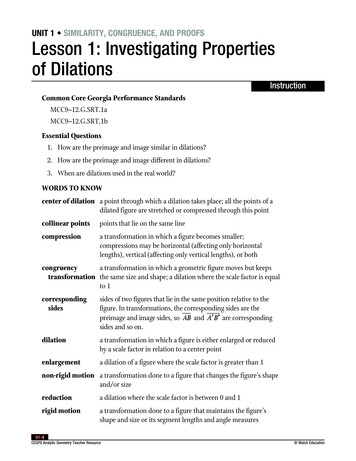
Transcription
6/*5 t SIMILARITY, CONGRUENCE, AND PROOFSLesson 1: Investigating Propertiesof DilationsInstructionCommon Core Georgia Performance tial Questions1. How are the preimage and image similar in dilations?2. How are the preimage and image different in dilations?3. When are dilations used in the real world?WORDS TO KNOWcenter of dilation a point through which a dilation takes place; all the points of adilated figure are stretched or compressed through this pointcollinear pointspoints that lie on the same linecompressiona transformation in which a figure becomes smaller;compressions may be horizontal (affecting only horizontallengths), vertical (affecting only vertical lengths), or botha transformation in which a geometric figure moves but keepscongruencytransformation the same size and shape; a dilation where the scale factor is equalto 1correspondingsidessides of two figures that lie in the same position relative to thefigure. In transformations, the corresponding sides are thepreimage and image sides, so AB and Ae Be are correspondingsides and so on.dilationa transformation in which a figure is either enlarged or reducedby a scale factor in relation to a center pointenlargementa dilation of a figure where the scale factor is greater than 1non-rigid motion a transformation done to a figure that changes the figure’s shapeand/or sizereductiona dilation where the scale factor is between 0 and 1rigid motiona transformation done to a figure that maintains the figure’sshape and size or its segment lengths and angle measuresU1-4CCGPS Analytic Geometry Teacher Resource Walch Education
6/*5 t SIMILARITY, CONGRUENCE, AND PROOFSLesson 1: Investigating Properties of DilationsInstructionscale factora multiple of the lengths of the sides from one figure to thetransformed figure. If the scale factor is larger than 1, then thefigure is enlarged. If the scale factor is between 0 and 1, then thefigure is reduced.stretcha transformation in which a figure becomes larger; stretches maybe horizontal (affecting only horizontal lengths), vertical (affectingonly vertical lengths), or bothRecommended Resources IXL Learning. “Transformations: Dilations: Find the Coordinates.”http://www.walch.com/rr/00017This interactive website gives a series of problems and scores them immediately. Ifthe user submits a wrong answer, a description and process for arriving at the correctanswer are provided. These problems start with a graphed figure. Users are asked toinput the coordinates of the dilated figure given a center and scale factor. IXL Learning. “Transformations: Dilations: Graph the Image.”http://www.walch.com/rr/00018This interactive website gives a series of problems and scores them immediately. Ifthe user submits a wrong answer, a description and process for arriving at the correctanswer are provided. These problems start with a graphed figure. Users are asked todraw a dilation of the figure on the screen using a point that can be dragged, given acenter and scale factor. IXL Learning. “Transformations: Dilations: Scale Factor and s interactive website gives a series of problems and scores them immediately. Ifthe user submits a wrong answer, a description and process for arriving at the correctanswer are provided. These problems start with a graphed preimage and image. Usersare required to choose whether the figure is an enlargement or a reduction. Otherproblems ask users to enter the scale factor. Math Is Fun. “Resizing.”http://www.walch.com/rr/00020This website gives a brief explanation of the properties of dilations and how toperform them. The site also contains an interactive applet with which users can selecta shape, a center point, and a scale factor. The computer then generates the dilatedimage. After users explore the applet, they may answer eight multiple-choice questionsin order to check understanding.U1-5 Walch EducationCCGPS Analytic Geometry Teacher Resource
NAME:6/*5 t SIMILARITY, CONGRUENCE, AND PROOFSLesson 1: Investigating Properties of DilationsLesson 1.1.1: Investigating Properties of Parallelism and the CenterWarm-Up 1.1.1A college has a wide-open space in the center of the campus. Landscape architects have proposedgardens at the four corners of the open space. Each garden would be in the shape of a triangle. Thefirst garden is pictured below.yA (–7, 3)1098B (–3, 7)7654C (–3, 3)321-10 -9 -8 -7 -6 -5 -4 -3 -2 -1 0-1-2-3-4-5-6-7-8-9-10x1 2 3 4 5 6 7 8 9 101. Perform a transformation of the first garden to create a second garden at the opposite vertexof the open space. The opposite vertex lies in Quadrant IV. Write the coordinates of the newgarden and state the transformation you used.2. Is the transformation you performed a rigid motion? Explain.U1-6CCGPS Analytic Geometry Teacher Resource Walch Education
6/*5 t SIMILARITY, CONGRUENCE, AND PROOFSLesson 1: Investigating Properties of DilationsInstructionLesson 1.1.1: Investigating Properties of Parallelism and the CenterCommon Core Georgia Performance StandardMCC9–12.G.SRT.1aWarm-Up 1.1.1 DebriefA college has a wide-open space in the center of the campus. Landscape architects have proposedgardens at the four corners of the open space. Each garden would be in the shape of a triangle. Thefirst garden is pictured below.yA (–7, 3)1098B (–3, 7)7654C (–3, 3)321-10 -9 -8 -7 -6 -5 -4 -3 -2 -1 0-1-2-3-4-5-6-7-8-9-10x1 2 3 4 5 6 7 8 9 101. Perform a transformation of the first garden to create a second garden at the opposite vertexof the open space. The opposite vertex lies in Quadrant IV. Write the coordinates of the newgarden and state the transformation you used.There are two possibilities.The first is to reflect the garden over the line y x.U1-7 Walch EducationCCGPS Analytic Geometry Teacher Resource
6/*5 t SIMILARITY, CONGRUENCE, AND PROOFSLesson 1: Investigating Properties of DilationsInstructionry " x ( x , y ) " ( y , x )A′ ry x ( A) ry x ( 7, 3) (3, 7)B ′ ry x ( B ) ry x ( 3, 7) (7, 3)C ′ ry x (C ) ry x ( 3, 3) (3, 3)This results in the following graph:yA (–7, 3)1098B (–3, 7)7654C (–3, 3)321-10 -9 -8 -7 -6 -5 -4 -3 -2 -1 0-1-2-3-4-5-6-7-8-9-10x1 2 3 4 5 6 7 8 9 10C (3, –3) B (7, –3)A (3, –7)The second possibility is to rotate the garden 180º counterclockwise about the origin.R180 ( x , y ) ( x , y )A′ R180 ( A) R180 ( 7, 3) (7, 3)B ′ R180 ( B ) R180 ( 3, 7) (3, 7)C ′ R180 ( C ) R180 ( 3, 3) (3, 3)U1-8CCGPS Analytic Geometry Teacher Resource Walch Education
6/*5 t SIMILARITY, CONGRUENCE, AND PROOFSLesson 1: Investigating Properties of DilationsInstructionThis results in the following graph:yA (–7, 3)1098B (–3, 7)7654C (–3, 3)321-10 -9 -8 -7 -6 -5 -4 -3 -2 -1 0-1-2-3-4-5-6-7-8-9-10x1 2 3 4 5 6 7 8 9 10C (3, –3) A (7, –3)B (3, –7)Observe that the shapes of the graphs for both possibilities are identical.2. Is the transformation you performed a rigid motion? Explain.Reflections and rotations are rigid motions. They preserve angle and length measures. Theresult of either transformation is a congruent figure.Connection to the Lesson Students will extend previous understandings of rigid motions to include non-rigid motions. Students will work with vertices on the coordinate plane.U1-9 Walch EducationCCGPS Analytic Geometry Teacher Resource
6/*5 t SIMILARITY, CONGRUENCE, AND PROOFSLesson 1: Investigating Properties of DilationsInstructionPrerequisite SkillsThis lesson requires the use of the following skills: operating with fractions, including complex fractions operating with decimals calculating slope determining parallel linesIntroductionThink about resizing a window on your computer screen. You can stretch it vertically, horizontally,or at the corner so that it stretches both horizontally and vertically at the same time. These are nonrigid motions. Non-rigid motions are transformations done to a figure that change the figure’sshape and/or size. These are in contrast to rigid motions, which are transformations to a figure thatmaintain the figure’s shape and size, or its segment lengths and angle measures.Specifically, we are going to study non-rigid motions of dilations. Dilations are transformations inwhich a figure is either enlarged or reduced by a scale factor in relation to a center point.Key Concepts Dilations require a center of dilation and a scale factor. The center of dilation is the point about which all points are stretched or compressed. The scale factor of a figure is a multiple of the lengths of the sides from one figure to thetransformed figure. Side lengths are changed according to the scale factor, k. The scale factor can be found by finding the distances of the sides of the preimage in relationto the image.length of image side" scale factorUse a ratio of corresponding sides to find the scale factor:length of preimage side The scale factor, k, takes a point P and moves it along a line in relation to the center so thatk CP CP ′ .U1-10CCGPS Analytic Geometry Teacher Resource Walch Education
6/*5 t SIMILARITY, CONGRUENCE, AND PROOFSLesson 1: Investigating Properties of DilationsInstructionPk t CP CPPCP is under a dilation of scale factor k through center C. If the scale factor is greater than 1, the figure is stretched or made larger and is called anenlargement. (A transformation in which a figure becomes larger is also called a stretch.) If the scale factor is between 0 and 1, the figure is compressed or made smaller and is called areduction. (A transformation in which a figure becomes smaller is also called a compression.) If the scale factor is equal to 1, the preimage and image are congruent. This is called acongruency transformation. Angle measures are preserved in dilations. The orientation is also preserved. The sides of the preimage are parallel to the corresponding sides of the image. The corresponding sides are the sides of two figures that lie in the same position relative tothe figures. In transformations, the corresponding sides are the preimage and image sides, so AB andAe Be are corresponding sides and so on. The notation of a dilation in the coordinate plane is given by Dk(x, y) (kx, ky). The scale factoris multiplied by each coordinate in the ordered pair. The center of dilation is usually the origin, (0, 0).U1-11 Walch EducationCCGPS Analytic Geometry Teacher Resource
6/*5 t SIMILARITY, CONGRUENCE, AND PROOFSLesson 1: Investigating Properties of DilationsInstruction If a segment of the figure being dilated passes through the center of dilation, then the imagesegment will lie on the same line as the preimage segment. All other segments of the imagewill be parallel to the corresponding preimage segments. The corresponding points in the preimage and image are collinear points, meaning they lieon the same line, with the center of dilation. T'U'V' is TUV under a dilationof scale factor k about center C.V'VT'TU'UCProperties of Dilations1. Shape, orientation, and angles are preserved.2. All sides change by a single scale factor, k.3. The corresponding preimage and image sides are parallel.4. The corresponding points of the figure are collinear with the center of dilation.Common Errors/Misconceptions forgetting to check the ratio of all sides from the image to the preimage in determining ifa dilation has occurred inconsistently setting up the ratio of the side lengths confusing enlargements with reductions and vice versaU1-12CCGPS Analytic Geometry Teacher Resource Walch Education
6/*5 t SIMILARITY, CONGRUENCE, AND PROOFSLesson 1: Investigating Properties of DilationsInstructionGuided Practice 1.1.1Example 1Is the following transformation a dilation? Justify your answer using the properties of dilations.yD(–4, 4)D(–2, 2)10987654321-10 -9 -8 -7 -6 -5 -4 -3 -2 -1 0C-1-2-3-4-5-6-7-8-9-10E(4, 2)E(2, 1)x1 2 3 4 5 6 7 8 9 10F(2, –2)F(4, –4)1. Verify that shape, orientation, and angles have been preserved from thepreimage to the image.Both figures are triangles in the same orientation. D D′ E E ′ F F ′The angle measures have been preserved.U1-13 Walch EducationCCGPS Analytic Geometry Teacher Resource
6/*5 t SIMILARITY, CONGRUENCE, AND PROOFSLesson 1: Investigating Properties of DilationsInstruction2. Verify that the corresponding sides are parallel.Dy (2 1) 11Dy (4 2) 21mDE and mD′ E ′ ;Dx ( 2 2) 44Dx ( 4 4) 84therefore, DE ( De E e .By inspection, EF ( E e F e because both lines are vertical; therefore, theyhave the same slope and are parallel.Dy [2 ( 2)] 4Dy [4 ( 4)] 8 1 and mD′ F ′ 1 ; Dx ( 2 2) 4Dx ( 4 4) 8therefore, DF ( D eF e . In fact, these two segments, DF and De F e , lie onthe same line.mDF All corresponding sides are parallel.3. Verify that the distances of the corresponding sides have changed by acommon scale factor, k.We could calculate the distances of each side, but that would take alot of time. Instead, examine the coordinates and determine if thecoordinates of the vertices have changed by a common scale factor.The notation of a dilation in the coordinate plane is given byDk(x, y) (kx, ky).Divide the coordinates of each vertex to determine if there is acommon scale factor.D( 2, 2) D′( 4, 4)E (2,1) E ′(4, 2)F (2, 2) F ′(4, 4)x D ′ 4yD ′ 4xE ′ 4yE ′ 2xF ′ 4yF ′ 4 2; 2; 2 2; 2 2x D 2yD 2xE 2yE 1xF 2yF 2Each vertex’s preimage coordinate is multiplied by 2 to create thecorresponding image vertex. Therefore, the common scale factor is k 2.U1-14CCGPS Analytic Geometry Teacher Resource Walch Education
6/*5 t SIMILARITY, CONGRUENCE, AND PROOFSLesson 1: Investigating Properties of DilationsInstruction4. Verify that corresponding vertices are collinear with the center ofdilation, C.yD(–4, 4)D(–2, 2)10987654321-10 -9 -8 -7 -6 -5 -4 -3 -2 -1 0C-1-2-3-4-5-6-7-8-9-10E(4, 2)E(2, 1)x1 2 3 4 5 6 7 8 9 10F(2, –2)F(4, –4)A straight line can be drawn connecting the center with thecorresponding vertices. This means that the corresponding vertices arecollinear with the center of dilation.5. Draw conclusions.The transformation is a dilation because the shape, orientation,and angle measures have been preserved. Additionally, the size haschanged by a scale factor of 2. All corresponding sides are parallel,and the corresponding vertices are collinear with the centerof dilation.U1-15 Walch EducationCCGPS Analytic Geometry Teacher Resource
6/*5 t SIMILARITY, CONGRUENCE, AND PROOFSLesson 1: Investigating Properties of DilationsInstructionExample 2Is the following transformation a dilation? Justify your answer using the properties of dilations.y109876T5(0, 5)4321-10 -9 -8 -7 -6 -5 -4 -3 -2 -1 0C-1-2-3-4-5-6-7-8-9-10U(6, 5)U(9, 5)x1 2 3 4 5 6 7 8 9 10V(6, 0)V(9, 0)1. Verify that shape, orientation, and angles have been preserved from thepreimage to the image.The preimage and image are both rectangles with the same orientation.The angle measures have been preserved since all angles are rightangles.U1-16CCGPS Analytic Geometry Teacher Resource Walch Education
6/*5 t SIMILARITY, CONGRUENCE, AND PROOFSLesson 1: Investigating Properties of DilationsInstruction2. Verify that the corresponding sides are parallel.TU e is on the same line as TU ; therefore, TU (TU e .CV e is on the same line as CV ; therefore, CV (CV e .By inspection, UV and U eV e are vertical; therefore, UV (U eV e .TC remains unchanged from the preimage to the image.All corresponding sides are parallel.3. Verify that the distances of the corresponding sides have changed by acommon scale factor, k.Since the segments of the figure are on a coordinate plane and areeither horizontal or vertical, find the distance by counting.In /TUVC :TU VC 9UV CT 5In /TU eV eC :TU ′ V ′C 6U ′V ′ CT 5The formula for calculating the scale factor is:scale factor length of image sidelength of preimage sideStart with the horizontal sides of the rectangle.TU ′ 6 2 TU 9 3V ′C6 2 VC 9 32Both corresponding horizontal sides have a scale factor of3.Next, calculate the scale factor of the vertical sides.U ′V ′ 5 1UV 5CT5" "1CT 5Both corresponding vertical sides have a scale factor of 1.U1-17 Walch EducationCCGPS Analytic Geometry Teacher Resource
6/*5 t SIMILARITY, CONGRUENCE, AND PROOFSLesson 1: Investigating Properties of DilationsInstruction4. Draw conclusions.The vertical corresponding sides have a scale factor that is not2consistent with the scale factor of for the horizontal sides. Since all3corresponding sides do not have the same common scale factor,the transformation is NOT a dilation.Example 3The following transformation represents a dilation. What is the scale factor? Does this indicateenlargement, reduction, or congruence?A'A3122.5C'103.75B'C15B1. Determine the scale factor.Start with the ratio of one set of corresponding sides.scale factor A′ B′AB length of image sidelength of preimage side2.5 1 10 41The scale factor appears to be4.U1-18CCGPS Analytic Geometry Teacher Resource Walch Education
6/*5 t SIMILARITY, CONGRUENCE, AND PROOFSLesson 1: Investigating Properties of DilationsInstruction2. Verify that the other sides maintain the same scale factor.B′C ′ 3.75 1C ′ A′ 3 1 and . Therefore,BC15 4CA 12 4A′ B′ B′C ′ C ′ A′ 11 and the scale factor, k, is .ABBCCA 443. Determine the type of dilation that has occurred.If k 1, then the dilation is an enlargement.If 0 k 1, then the dilation is a reduction.If k 1, then the dilation is a congruency transformation.1Since k " , k is between 0 and 1, or 0 k 1.4The dilation is a reduction.U1-19 Walch EducationCCGPS Analytic Geometry Teacher Resource
NAME:6/*5 t SIMILARITY, CONGRUENCE, AND PROOFSLesson 1: Investigating Properties of DilationsProblem-Based Task 1.1.1: Prettying Up the PentagonThe Pentagon, diagrammed below, is one of the world’s largest office buildings. The outside wallsare each 921 feet long and are a dilation of the inner walls through the center of the courtyard. Thecourtyard is the area inside the inner wall. Since the courtyard is surrounded by the inner walls, eachside of the courtyard is the same length as the inner walls. The dashed lines represent a walkway thatborders a garden. The walkway is a dilation of the inner wall of the office building.A team of landscapers has been hired to update the courtyard. The landscapers need to know theperimeter of the walkway in order to install some temporary fencing while the courtyard is redone.What is the perimeter of the walkway if the dilation from the inner wall to the walkway has a scalefactor of 0.25? What relationship does the scale factor have to the perimeters of the figures?921 ft264 ftU1-20CCGPS Analytic Geometry Teacher Resource Walch Education
NAME:6/*5 t SIMILARITY, CONGRUENCE, AND PROOFSLesson 1: Investigating Properties of DilationsProblem-Based Task 1.1.1: Prettying Up the PentagonCoachinga. What is the length of one side of the inner wall (the preimage)?b. What is the scale factor used to dilate the inner wall to determine the walkway?c. How do you calculate the length of each side of the walkway in the pentagonal figure in thecourtyard?d. What is the length of each side of the walkway?e. How many sides are there in a pentagon?f. What is the perimeter of the walkway?g. What is the perimeter of the inner wall?h. What is the scale factor of the perimeter of the inner wall to the perimeter of the walkway?i. How do the scale factors of the lengths of each side of the inner wall and the walkway compareto the perimeters of the inner wall and the walkway?j. What is the scale factor of the inner wall to the outer wall?k. What is the perimeter of the outer wall?l. What is the scale factor of the perimeter of the inner wall to the perimeter of the outer wall?m. How do the scale factors of the individual side lengths of the inner and outer walls compare tothe perimeters of the inner and outer walls?n. What can you conclude about the scale factors of perimeters of dilated figures?U1-21 Walch EducationCCGPS Analytic Geometry Teacher Resource
6/*5 t SIMILARITY, CONGRUENCE, AND PROOFSLesson 1: Investigating Properties of DilationsInstructionProblem-Based Task 1.1.1: Prettying Up the PentagonCoaching Sample Responsesa. What is the length of one side of the inner wall (the preimage)?264 feetb. What is the scale factor used to dilate the inner wall to determine the walkway?0.25c. How do you calculate the length of each side of the walkway in the pentagonal figure in thecourtyard?Multiply the preimage side by the scale factor: 264(0.25).d. What is the length of each side of the walkway?264(0.25) 66The length of each side of the walkway in the pentagonal figure is 66 feet.e. How many sides are there in a pentagon?A pentagon has 5 sides.f. What is the perimeter of the walkway?5(66) 330The perimeter of the walkway is 330 feet.g. What is the perimeter of the inner wall?5(264) 1320The perimeter of the inner wall is 1,320 feet.h. What is the scale factor of the perimeter of the inner wall to the perimeter of the walkway?perimeter of walkwayperimeter of inner wall"3301320" 0.25U1-22CCGPS Analytic Geometry Teacher Resource Walch Education
6/*5 t SIMILARITY, CONGRUENCE, AND PROOFSLesson 1: Investigating Properties of DilationsInstructioni. How do the scale factors of the lengths of each side of the inner wall and the walkway compareto the perimeters of the inner wall and the walkway?The scale factor of each wall is the same as the scale factor of the perimeters.j. What is the scale factor of the inner wall to the outer wall?length of inner walllength of outer wall 264921 0.29k. What is the perimeter of the outer wall?5(921) 4605The perimeter of the outer wall is 4,605 feet.l. What is the scale factor of the perimeter of the inner wall to the perimeter of the outer wall?perimeter of inner wallperimeter of outer wall 13204605 0.29m. How do the scale factors of the individual side lengths of the inner and outer walls compare tothe perimeters of the inner and outer walls?The scale factors are the same.n. What can you conclude about the scale factors of perimeters of dilated figures?If a figure is dilated, the perimeter of the preimage to the image has the same scale factor asthe dilation.Recommended Closure ActivitySelect one or more of the essential questions for a class discussion or as a journal entry prompt.U1-23 Walch EducationCCGPS Analytic Geometry Teacher Resource
NAME:6/*5 t SIMILARITY, CONGRUENCE, AND PROOFSLesson 1: Investigating Properties of DilationsPractice 1.1.1: Investigating Properties of Parallelism and the CenterDetermine whether each of the following transformations represents a dilation. Justify your answerusing the properties of dilations.1. Compare polygon CMNOP to polygon CM e N eO e P e .y1098765M4(0, 4)3M2(0, 2) 1N (4, 8)N (2, 4)O(8, 4)O(4, 2)x-10 -9 -8 -7 -6 -5 -4 -3 -2 -1 0C-1-2-3-4-5-6-7-8-9-101 2 3 4 5 6 7 8 9 10P(4, 0)P(8, 0)2. Compare -TUV to -T eU eV e .y1098765T (–1, 3) 4321T-10 -9 -8 -7 -6 -5 -4 -3 -2 -1 0-1V (–2, –1)-2-3V (–6, –3)-4-5-6-7-8-9-10(– 1 ,1)3C1x2 3 4 5 6 7 8 9 10U (3, –1)U (9, –3)continuedU1-24CCGPS Analytic Geometry Teacher Resource Walch Education
NAME:6/*5 t SIMILARITY, CONGRUENCE, AND PROOFSLesson 1: Investigating Properties of Dilations3. Compare -QRC to -QR eC .1098yQ(0, 8)7654321x-10 -9 -8 -7 -6 -5 -4 -3 -2 -1 0C-11234R (3, 0)56789 106789 10R (6, 0)-2-3-4-5-6-7-8-9-104. Compare /CMNO to /CM e N eO .10y987M6(0, 4)N (2, 6)M4(0, 4)N (2, 4)5321x-10 -9 -8 -7 -6 -5 -4 -3 -2 -1 0C-1123O (2, 0)45-2-3-4-5-6-7-8-9-10continuedU1-25 Walch EducationCCGPS Analytic Geometry Teacher Resource
NAME:6/*5 t SIMILARITY, CONGRUENCE, AND PROOFSLesson 1: Investigating Properties of DilationsFor problems 5 and 6, the following transformations represent dilations. Determine the scale factorand whether the dilation is an enlargement, a reduction, or a congruency .59.211.614.5CSS4.4R5.5RUse the given information in each problem that follows to answer the questions.7. A right triangle has the following side lengths: AB 13, BC 12, and CA 5. The triangle is2624dilated so that the image has side lengths A′ B′ , B′C ′ , and C ′ A′ 2 . What is the55scale factor? Does this represent an enlargement, a reduction, or a congruency transformation?continuedU1-26CCGPS Analytic Geometry Teacher Resource Walch Education
NAME:6/*5 t SIMILARITY, CONGRUENCE, AND PROOFSLesson 1: Investigating Properties of Dilations8. Derald is building a playhouse for his daughter. He wants the playhouse to look just like thefamily’s home, so he’s using the drawings from his house plans to create the plans for theplayhouse. The diagram below shows part of a scale drawing of a roof truss used in the house.What is the scale factor of the roof truss from the house drawing to the playhouse drawing?10y987T (8, 6)654T(4, 3)321x-10 -9 -8 -7 -6 -5 -4 -3 -2 -1 0C-112345U (4, 0)6789 10U (8, 0)-2-3-4-5-6-7-8-9-10continuedU1-27 Walch EducationCCGPS Analytic Geometry Teacher Resource
NAME:6/*5 t SIMILARITY, CONGRUENCE, AND PROOFSLesson 1: Investigating Properties of Dilations9. On Board, a luggage manufacturer, has had great success with a certain model of carry-onluggage. Feedback suggests that customers would prefer that the company sell different sizes ofluggage with the same design as the carry-on. The graph below represents the top view of theoriginal carry-on model and a proposed larger version of the same luggage. Does the new pieceof luggage represent a dilation of the original piece of luggage? Why or why not?y10987654321-10 -9 -8 -7 -6 -5 -4 -3 -2 -1 0-1-2-3-4-5-6-7-8-9-10T (0, 6)T (0, 4)U(8, 6)U(6, 4)xC12 3 4 5 6 7 8 9 10VV(6, 0) (8, 0)10. A university wants to put in a courtyard for a new building. The courtyard is bounded bythe coordinates P (–4, 0), Q (–2, –6), R (6, 2), and S (0, 4). The landscape architects created adilation of the space through the center C (0, 0) to outline the garden. The garden is boundedby the points P' (–2.4, 0), Q' (–1.2, –3.6), R' (3.6, 1.2), and S' (0, 2.4). What is the scale factor?Does this represent an enlargement, a reduction, or a congruency transformation?U1-28CCGPS Analytic Geometry Teacher Resource Walch Education
NAME:6/*5 t SIMILARITY, CONGRUENCE, AND PROOFSLesson 1: Investigating Properties of DilationsLesson 1.1.2: Investigating Scale FactorsWarm-Up 1.1.2Hideki is babysitting his little sister and takes her to the park. While pushing her on the swing, henotices that if he pushes her so that she swings as high as the top of his head and then lets her gowithout pushing her, she only swings as high as his shoulders.1. If Hideki is 6 feet tall and the height at his shoulders is 5.1 feet, what is the scale factor of thechange in height of his sister’s swing?2. Rewrite this change as a percentage.3. What is the reciprocal of this change in height?4. Rewrite this reciprocal as a percentage.5. What might it mean in the context of the problem if you applied the reciprocal of the change tothe height when Hideki’s sister is swinging as high as the top of his head?U1-29 Walch EducationCCGPS Analytic Geometry Teacher Resource
6/*5 t SIMILARITY, CONGRUENCE, AND PROOFSLesson 1: Investigating Properties of DilationsInstructionLesson 1.1.2: Investigating Scale FactorsCommon Core Georgia Performance StandardMCC9–12.G.SRT.1bWarm-Up 1.1.2 DebriefHideki is babysitting his little sister and takes her to the park. While pushing her on the swing henotices that if he pushes her so that she swings as high as the top of his head and then lets her gowithout pushing her, she only swings as high as his shoulders.1. If Hideki is 6 feet tall and the height at his shoulders is 5.1 feet, what is the scale factor of thechange in height of his sister’s swing?height after 1 swing 5.1"" 0.85initial height62. Rewrite this change as a percentage.0.85(100) 85%3. What is the reciprocal of this change in height?5.16is.The reciprocal of65.14. Rewrite this reciprocal as a percentage.6 1.185.11.18(100) 118%5. What might it mean in the context of the problem if you applied the reciprocal of the change tothe height when Hideki’s sister is swinging as high as the top of his head?Hideki might have pushed his sister again to cause her to swing higher.Connection to the Lesson Students will need to be able to convert decimals to percents. Students can draw on the connection between scale factors and percent change in termsof when the dilation is an enlargement or a reduction. Students can use this connection topredict the effects of dilating a figure given a scale factor and center.U1-30CCGPS Analytic Geometry Teacher Resource Walch Education
6/*5 t SIMILARITY, CONGRUENCE, AND PROOFSLesson 1: Investigating Properties of DilationsInstructionPrerequisite SkillsThis lesson requires the use of the following skills: operating with fractions, decimals, and percents converting among fractions, decimals, and percentsIntroductionA figure is dilated if the preimage can be mapped to the image using a scale factor through a centerpoint, usually the origin. You have been determining if figures have been dilated, but how do you createa dilation? If the dilation is centered about the origin, use the scale factor and multiply each coordinatein the figure by that scale factor. If a distance is given, multiply the distance by the scale factor.Key Concepts The notation is as follows: Dk ( x , y ) " ( kx , ky ) . Multiply each coordinate of the figure by the scale factor when the center is at (0, 0).y10987654321-10 -9 -8 -7 -6 -5 -4 -3 -2 -1 0-1-2-3-4-5-6-7-8-9-10 k t CD CDD (kx,ky)D (x, y)C1x2 3 4 5 6 7 8 9 10The lengths of each side in a figure also are multiplied by the scale factor.U1-31 Walch EducationCCGPS Analytic Geometry Teacher Resource
6/*5 t SIMILARITY, CONGRUENCE, AND PROOFSL
Lesson 1: Investigating Properties of Dilations 6/*5 t SIMILARITY, CONGRUENCE, AND PROOFS Instruction CCGPS Analytic Geometry Teacher Resource
